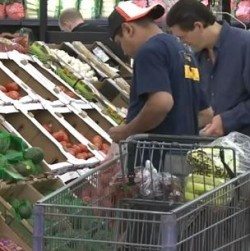Labor & Economy
Steep Food Stamp Cuts Due November 1

In terms of the math, figuring out who will be affected in the country will be easy. Just walk outside and count the first seven people on the street – and then remember one of them.
What might be harder is the realization that less does not mean more when it comes to families and individuals experiencing poverty and needing food to survive, especially during the coming cold months.
An estimated 47.6 million people in the country will see a total of $5 billion in across-the-board cuts in food stamp support, officially starting Friday, because a 2009 law that supported a boost in assistance will lapse, according to a report from the Center on Budget and Policy Priorities.
While a family with three people will see a $29 monthly cut in the safety net program, a family with four people will face a $36 monthly reduction, the Washington, D.C.-based research group said, referring to the period between November 2013 and September 2014.
A one-person household will see a drop of $11 per month and a two-person household will have $20 fewer dollars each month for food.
Food stamps, formally known as the Supplemental Nutrition Assistance Program (SNAP), have never experienced cuts that have affected all recipients, the research group said, adding: “There have been some cuts in specific states, but these cuts have not typically been as large or affected as many people as what will occur.”
The $5 billion cuts also include residents of U.S. territories.
Some food stamp recipients on Tuesday were concerned because they had not been informed that the cuts were scheduled to start this week. On Tuesday afternoon, Equal Voice News contacted the U.S. Department of Agriculture, which administers SNAP, for additional information about the upcoming reductions and what recipients could do.
On Wednesday, a department spokesman referred to a government blog post by Kevin Concannon, USDA undersecretary, in which he says there is a commitment to providing low-income families and children with access to nutrition assistance programs as they “get back on their feet.”
State officials were supposed to have informed recipients, who live in 23 million households, of the news, the Center on Budget and Policy Priorities said. That could have been done via letters mailed to a household, email, telephone, in-person meetings, newsletters, flyers and posters.
The center pointed to research that calls into question the adequacy of the SNAP program, such as unrealistic assumptions about the price of food.
“We can reasonably assume that a reduction in SNAP benefit levels of this size will significantly increase the number of poor households that have difficulty affording adequate food this fall,” the research organization said.
The 2009 law, known as the American Recovery and Reinvestment Act, boosted food stamp payments to people in need to address hardship caused by the Great Recession.
Congress has not acted to address these specific food stamp reductions, which will affect 15 percent of the people in the country.
Federal lawmakers are considering farm legislation, which covers food stamp support. Some lawmakers in the U.S. House of Representatives want billions of dollars in cuts to food stamps, saying its budget is too large .
Such assistance programs actually benefit individuals and families who are experiencing poverty, the USDA has found.
In August, the USDA issued a report saying that participation in the food stamp program provides better “food security” for individuals and families, especially low-income children.
“The results of this study reiterate the vital role of SNAP in reducing hunger and ensuring that the next generation has access to the nutritious food it needs to grow up healthy and strong,” Concannon said in a statement.
Children who live in “food insecure” households face higher health and development risks than kids who have more food stability at home, the USDA said.
Individuals and families who receive food stamps, the Center on Budget and Policy Priorities said, can call or visit local offices that administer the safety net program for more information or possible referrals to organizations that can help fill the gap created by the lower assistance amounts.
The center encouraged officials to work with food banks, human service organizations, the retail community and government agencies to be prepared for people who are in need of food assistance.
(Brad Wong is assistant news editor for Equal Voice News, where his post first appeared. Republished with permission.)

-

 Locked OutDecember 16, 2025
Locked OutDecember 16, 2025This Big L.A. Landlord Turned Away People Seeking Section 8 Housing
-

 Locked OutDecember 23, 2025
Locked OutDecember 23, 2025Section 8 Housing Assistance in Jeopardy From Proposed Cuts and Restrictions
-

 The SlickDecember 19, 2025
The SlickDecember 19, 2025‘The Poor Are in a Very Bad State’: Climate Change Accelerates California’s Cost-of-Living Crisis
-

 Locked OutDecember 17, 2025
Locked OutDecember 17, 2025Credit History Remains an Obstacle for Section 8 Tenants, Despite Anti-Discrimination Law
-

 Latest NewsDecember 22, 2025
Latest NewsDecember 22, 2025Trump’s War on ICE-Fearing Catholics
-

 Column - State of InequalityDecember 18, 2025
Column - State of InequalityDecember 18, 2025Beyond Hollywood, Rob Reiner Created Opportunity for Young Children Out of a Massive Health Crisis
-

 Striking BackDecember 17, 2025
Striking BackDecember 17, 2025‘There’s Power in Numbers’
-

 Column - State of InequalityDecember 24, 2025
Column - State of InequalityDecember 24, 2025Where Will Gov. Newsom’s Evolution on Health Care Leave Californians?

